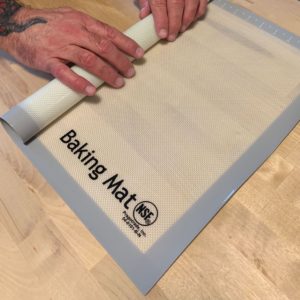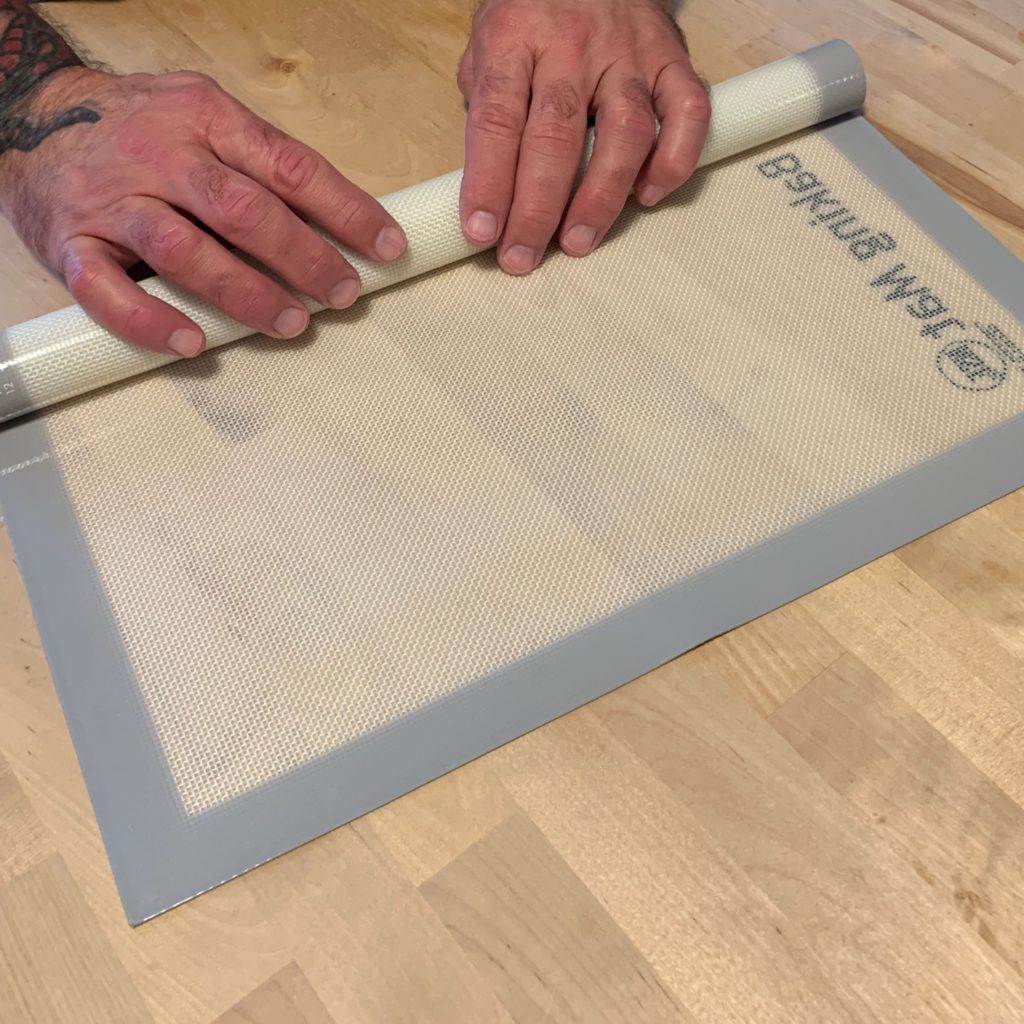One of the great things about living in our time is . . . the silicone baking mat. This is a magnificent piece of technology, and if you have even a passing interest in using an oven, you should have at least one.
But once you have one (or two or three), you’ll confront the question of how to store your silicone baking mats. I roll mine — and in doing so, I open myself to a conundrum.

Consider: If you roll your silicone baking mat with the working side inside, then you might get curling at the edges while you’re trying to roll out your pizza crust.

But if you roll your mat up with the working side outside, then you run the risk that your working surface gets dusty or scratched.
What to do?
Being a philosopher, I won’t resort to the usual easy solutions — like quoting an authority or telling you what you should care about or informing you about what “most people” do. You can find plenty of authorities or priests or pundits if you need them, right here on the internet. Rather, I’m going to take you on a little philosophical journey.
How do we decide, in cases like silicone map storage, what to do?
One obvious answer is to appeal to “the best way” to store the mats. But that’s exactly the problem: “the best way” isn’t obvious. “It depends,” we might even say. But what does it depend on?
One might argue that, with respect to an undertaking, we determine the best way by choosing evaluative criteria on the basis of which to make the assessment. If we decide to adopt “no curling” as a value, that becomes the evaluative criterion, and voilá: outside-in is “the best way” to store the mats. If we adopt “no dust or scratches” as our guiding value, then it’s just as obvious that inside-out is the way to go. And if we adopt classical perspective as our standard, then we’re going to have to rate the seeing-around-corners perspective of many of Picasso’s famous paintings pretty low.
The best way, then, depends on the selection of evaluative criteria that provide us guidance in doing something. And this insight alone is enlightening: The best way isn’t a static “thing” that we can adopt or not; rather, it’s a way of doing something, of acting in the world that we can strive for. It’s an appeal to excellencifying.

Note that the evaluative criteria for doing or acting well is not the same as the criteria we invoke for doing that thing to begin with. Consider: You have two choices to make with respect to silicone baking mats. The logically prior choice is about whether to use silicone baking mats at all. That choice probably should not be driven by the best way to store them.
This distinction opens the door to a quandary that’s haunted ethics ever since people started forgetting to read Aristotle: There are very good ways to do very bad things. It doesn’t take much imagination to think of examples, and the interesting thing is that we can articulate clear guiding principles for doing bad things extremely well.
If we want lives of flourishing as human beings — in other words, if we don’t forget to read Aristotle before contemplating our lives — then we must confront the challenges of what Aristotle calls prohairesis. Our first problem is how to translate this complex notion. In the tradition of Aristotle translation, people have opted for “decision,” which I admit is partially correct but also misleading. I argue that Aristotle uses the term prohairesis to mean the entire process of selecting not only an end but also the “best” means to achieve that end — and then committing to that activity in practice. That’s a lot to expect from a single English word or phrase, so in my translation, I just leave it as prohairesis.
Looking at our silicone mat conundrum from the perspective of prohairesis, we have a storage problem only if we’ve chosen to bake on silicone mats to begin with. If we have, then we’ve adopted baking on silicone mats as an “end,” in which case we will have the problem of how best to accomplish that end. And that is going to involve making informed choices about doing and acting in the world. Here’s where we will need to deliberate, not just about whether to use the mats, but about our evaluative criteria in the process of using them effectively. Of course, all this deliberative effort will be in vain if we don’t actually bake things from time to time on the mats. And of course, should we commit to this activity, we must have been motivated by the value of baking baked items on silicone mats — and doing so in ways that increase the richness of our lives.
In other words, all roads of prohairesis lead to lives of flourishing.
So, when someone asks me whether using silicone baking mats is the best way to bake, I invariably reply: It depends. What kind of life do you want to live?
As for you — you already know what to do:
Live your virtue.